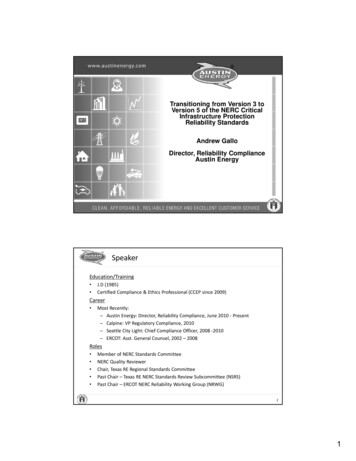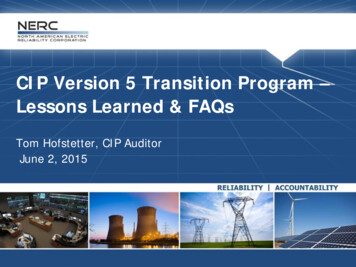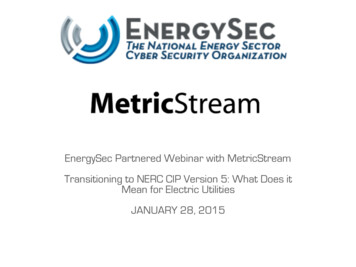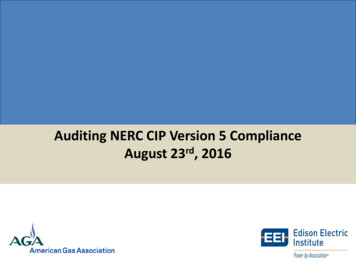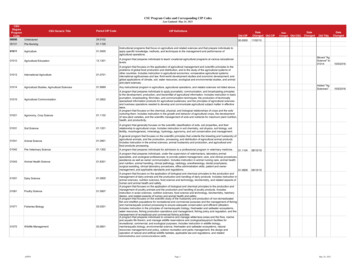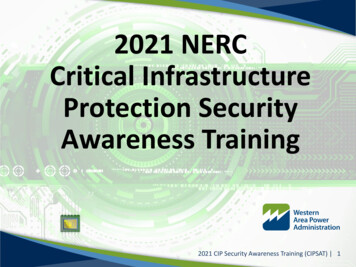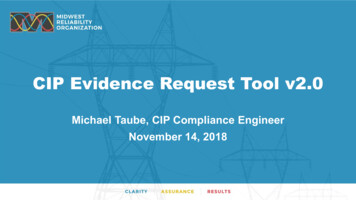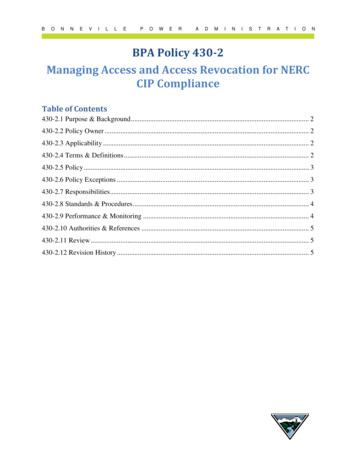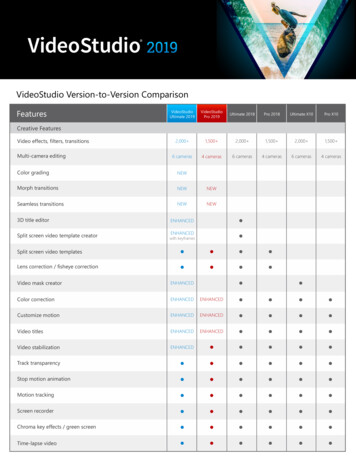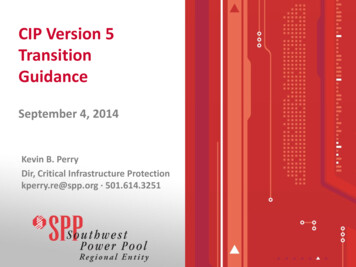
Transcription
CIP Version 5TransitionGuidanceSeptember 4, 2014Kevin B. PerryDir, Critical Infrastructure Protectionkperry.re@spp.org · 501.614.3251
Agenda Introduction Critical Asset Identification Options Newly Identified Critical Assets Updated Critical Cyber Asset List Changes to Existing Critical Assets / Critical CyberAssets Compliance Monitoring During the Transition Period Technical Feasibility Exceptions2
Introduction The goal of the CIP V5 Transition Guidance is to:–Provide Responsible Entities an efficient and effectivepath to full compliance with the CIP Version 5 ReliabilityStandards by the effective (enforcement) date.–Provide Responsible Entities a way to maintain CIPVersion 3 compliance while transitioning to Version 5through a flexible compliance monitoring andenforcement approach during the transition period.–Allow Responsible Entities begin to operate inaccordance with the CIP V5 Standards while the CIP V3Standards are still mandatory and enforceable.3
Introduction During the transition period, Responsible Entities may:–Continue to comply with all of the CIP V3 Standards, or–Begin transitioning to compliance with some or all ofthe CIP V5 StandardsRegional Entities will perform expanded outreach tohelp Responsible Entities achieve full compliance withthe CIP V5 Standards by the effective date.–Workshops–Webinars–On-site meetings / readiness reviews4
Introduction NERC has developed a “Mostly Compatible” matrixlinking each CIP V3 Requirement with its comparableCIP V5 Requirement. The matrix will: –Assist Responsible Entities in transitioning their CIPcompliance program from V3 to V5.–Assist Regional Entities and Responsible Entities withcompliance monitoring and enforcement during theTransition PeriodMatrix is found on the NERC web site patibility%20Tables.pdf5
Introduction6
Critical Asset Identification Options Option 1:–Continue to maintain a valid Risk-Based AssessmentMethodology (RBAM) pursuant to CIP-002-3,Requirement R1. The RBAM must include a procedure for conducting the riskbased assessment. The RBAM must include appropriate and justified evaluationcriteria for each type of asset being considered. The RBAM must be reviewed and approved annually. The RBAM must be applied at least annually to derive a list ofCritical Assets.7
Critical Asset Identification Options Option 2:–Responsible Entities that have already adopted the CIPV4 Critical Asset Criteria (CIP-002-4, Attachment 1), maycontinue to use the CIP V4 Critical Asset Criteria in lieuof maintaining a RBAM. Adoption of the V4 Critical Asset Criteria must have occurredbefore August 12, 2014. Critical Assets identified per criterion 1.4 (BlackstartResources) and criterion 1.5 (Cranking Paths) will not besubjected to the CIP V3 Standards, but Transmission OperatorControl Centers controlling cranking path assets will continueto be treated as Critical Assets. Annually approve the adoption of the V4 Critical AssetCriteria.8
Critical Asset Identification Options Option 3:–Responsible Entities may adopt the CIP V5 “High” and“Medium” Impact Rating Criteria (CIP-002-5.1,Attachment 1) to identify Critical Assets in lieu ofmaintaining a RBAM. May adopt the V5 Impact Rating Criteria at any time. May immediately apply the V5 Impact Rating Criteria toderive a new Critical Asset list. May immediately remove Critical Assets and associatedCritical Cyber Assets from the Critical Asset list that do notsatisfy any of the V5 High or Medium Impact Rating Criteria. Annually approve the adoption of the V5 Impact RatingCriteria.9
Critical Asset Identification Options Applying the CIP V5 “High” and “Medium” ImpactRating Criteria:–Read each Criterion statement as Critical Assetevaluation criteria.–Do not consider BES Cyber Systems located at orassociated with the assets described by the Criteria.–Any asset matching one or more “High” or “Medium”Impact Rating Criteria is a Critical Asset.–Any asset matching only a “Low” Impact RatingCriterion is a not a Critical Asset.10
Critical Asset Identification Options Additional Guidance:–Responsible Entities adopting either the CIP V4 CriticalAsset Criteria or the CIP V5 Impact Rating Criteria mustadopt the Criteria in their entirety, subject to thecaveats documented in the CIP V5 Transition Guidance.–Adoption of either the CIP V4 Critical Asset Criteria orthe CIP V5 Impact Rating Criteria should be documentedby a Memorandum of Record or other, similarmemorialization. A documented RBAM is not required.–Responsible Entities must annually apply the CIP V3RBAM or alternative CIP V4 or V5 Criteria to derive anupdated Critical Asset list.11
Newly Identified Critical Assets Adoption and application of either the CIP V4 CriticalAsset Criteria or the CIP V5 Impact Rating Criteria willresult in an updated Critical Asset list.–Most existing Critical Assets will continue to be CriticalAssets.–Some Critical Assets will not satisfy the Criteria and canbe immediately removed from the Critical Asset list.–New Critical Assets may be identified as a result ofadopting and applying the Criteria. Newly identified Critical Assets should be flagged on theupdated Critical Asset list as resulting from applying the CIP V4Critical Asset Criteria or the CIP V5 Impact Rating Criteria.12
Updated Critical Cyber Asset List After updating the Critical Asset list, the performanceof CIP-002-3, Requirement R3, will result in an updatedCritical Cyber Asset list. Any newly identified Critical Cyber Assets associatedwith a newly identified Critical Asset will not beexpected to come into compliance with the CIP V3Standards.–Newly identified Critical Cyber Assets should be flaggedon the updated Critical Cyber Asset list–Such Critical Cyber Assets will be taken straight to CIPV5 compliance per the CIP V5 Implementation Plan.13
Updated Critical Cyber Asset List Critical Cyber Assets associated with removed CriticalAssets may be immediately removed from the CriticalCyber Asset list.–Removed Critical Cyber Assets will immediately comeout of the CIP V3 compliance program.–Such Cyber Assets will likely come back into the CIPcompliance program under CIP V5 as Low impacting BESCyber Systems.–Resumed compliance under CIP V5 will be pursuant tothe CIP V5 Standards Implementation Plan.14
Updated Critical Cyber Asset List Existing Critical Cyber Assets that remained on theCritical Cyber Asset list after adoption and applicationof the CIP V4 or V5 Criteria and subsequentperformance of CIP-002-3, Requirement R3, shallremain in the CIP V3 compliance program through theTransition Period.–No lapse of CIP compliance is permitted.–CIP V3 compliance must be maintained subject to theprovisions of the CIP V5 Transition Guidance.–Replacement Cyber Assets must be CIP V3 or V5compliant upon commissioning.15
Changes to Existing CAs/CCAs Consistent with the CIP V3 Implementation Plan forNewly Identified Critical Cyber Assets and NewlyRegistered Entities and the CIP V5 ImplementationPlan, new and upgraded/replaced Critical Cyber Assetsresulting from a planned change must be fullycompliant upon commissioning.–During the Transition Period, compliance may be witheither the CIP V3 or CIP V5 standards.–Examples include planned replacement of theSCADA/EMS and planned conversion from a nonroutable to a routable protocol in a Transmissionsubstation or generating plant.16
Changes to Existing CAs/CCAs A planned change that elevates BES Cyber Systems to ahigher categorization during the Transition Periodmust be compliant with the higher impacting CIP V5requirements by the effective date of the requirement.– Example includes a planned increase in generation thatresults in a higher categorization of BES Cyber Systemsat the Control Center.Unplanned changes will need to be compliant by thelater of the CIP V5 Standards effective date or theCompliance Implementation date shown in the CIP V5Implementation Plan–Examples include Criteria 2.3 and 2.6 notifications.17
Compliance Monitoring During Transition Period On-site CIP compliance audits of Responsible Entitiesregistered as Reliability Coordinators, BalancingAuthorities, or Transmission Operators, and otherResponsible Entities with Critical Cyber Assets willcontinue through the Transition Period. Off-site CIP compliance audits of Responsible Entitieswith no Critical Cyber Assets (other than ReliabilityCoordinators, Balancing Authorities, and TransmissionOperators) are cancelled through the TransitionPeriod.–Self-reports, spot checks, and self-certifications still allowed.–Audits of “off-site entities” may resume with CIP V5.18
Compliance Monitoring During Transition Period Responsible Entities audited during the TransitionPeriod may choose to be audited against the CIP V3 orCIP V5 Standards.–Election made on requirement-by-requirement basis.–Election may be made on a site-by-site basis.Request for Information will be issued 45 days prior toissuance of the 90-day audit notice (135 days prior tothe audit).–SPP RE will issue a spreadsheet with selection options.–Entities will have 15 days to respond.19
Compliance Monitoring During Transition Period20
Compliance Monitoring During Transition Period At audit, in-scope requirements will be initiallyevaluated per the Responsible Entity’s selection.–If CIP V5 selected and compliance with the V5 languageis determined, the V5 compliance will be viewed as CIPV3 compliant and a “No Finding” will be issued.–If CIP V5 is selected and non-compliance with the V5language is determined, the audit team will revert backto the CIP V3 language. If V3 compliance is determined,a “No Finding” will be issued.–If neither CIP V3 nor V5 compliance is determined, a“Possible Violation” or “Area of Concern” will be issued.21
Compliance Monitoring During Transition Period If a CIP V5 Requirement is selected by the entity, a“Possible Violation” will not be found for any part ofthe Requirement that is unique to CIP V5.–The audit team will conduct outreach to help steer theResponsible Entity back on course to CIP V5 compliance.–An “Area of Concern” may be issued to document thefuture potential non-compliance issue.Example includes aspects of the annual securitytraining requirements of CIP-004-5, Requirement R2,such as Requirement R2.1.4 (the visitor controlprogram).22
Compliance Monitoring During Transition Period While not specified by the CIP V5 Transition Guidance,Responsible Entities selecting the CIP V3 audit optionwill not eliminate a CIP V5 evaluation opportunity.–If the V3 option is selected and non-compliance isdetermined, the audit team will determine if the issueof non-compliance would also be a CIP V5 violation.–If CIP V5 has eliminated the non-compliant aspect of theCIP V3 requirement, the audit team will issue an “Areaof Concern” and not a “Possible Violation.” Example includes lack of an Electronic Access Point for nonroutable communications as required by CIP-005-3,Requirement R1.23
Compliance Monitoring During Transition Period Mitigation of any Open Enforcement Actions duringthe Transition Period should focus on achieving fullcompliance with the “Mostly Compatible” CIP V5Requirement.–This includes violations found prior to the August 12,2014 release of the CIP V5 Transition Guidance thathave not completed mitigation.–Full compliance with the CIP V5 Standards must beachieved by the CIP V5 effective date.–An unmitigated Open Enforcement Action cannot beused to extend the CIP V5 compliance date.24
Technical Feasibility Exceptions Technical Feasibility Exceptions are still required forcertain CIP V5 Requirements.–Existing TFEs carried forward for equivalent CIP V5Requirements.–New TFEs required for CIP V5 Requirements with noequivalent V3 Requirement.–TFEs for CIP V3 Requirements with no equivalent V5Requirement will be terminated upon the CIP V5effective date.CIP V5 TFEs cannot be submitted before October 1,2015 to allow time for required portal changes.25
Technical Feasibility Exceptions TFEs under the CIP V3 Standards with equivalent CIPV5 Requirements (carry forward).CIP V3 RequirementCIP V5 RequirementCIP-005-3 / R4CIP-005-5 / R2 / Part 2.3CIP-007-3 / R2.3CIP-007-5 / R1 / Part 1.1CIP-007-3 / R6.4CIP-007-5 / R4 / Part 4.3CIP-007-3 / R5.3.3CIP-007-5 / R5 / Part 5.626
Technical Feasibility Exceptions New CIP V5 TFE-eligible Requirements with noequivalent CIP V3 Requirement rement R1,Part 1.4Requirement R1,Part 1.3Requirement R5,Part 5.1Requirement R1,Part 1.5Requirement R5,Part 5.7Requirement R3,Part 3.2Requirement R2,Part 2.1Requirement R2,Part 2.227
Technical Feasibility Exceptions CIP V3 TFEs no longer required under CIP 3.2R3.2R4R5.3R5.3.1R5.3.2R628
Helpful Resources SPP RE training–Past Webinar and workshops presentation materials–Video library–SPP RE monthly newsletterNERC–CIP V5 Standards and Implementation Plan–CIP V5 Transition Guidance–CIP V5 Transition Study Lessons Learned29
SPP RE CIP Team Kevin Perry, Director of Critical Infrastructure Protection(501) 614-3251 Shon Austin, Lead Compliance Specialist-CIP(501) 614-3273 Steven Keller, Lead Compliance Specialist-CIP(501) 688-1633 Jeremy Withers, Senior Compliance Specialist-CIP(501) 688-1676 Robert Vaughn, Compliance Specialist II-CIP(501) 482-230130
CIP Version 5 Transition Guidance September 4, 2014 Kevin B. Perry . Dir, Critical Infrastructure Protection kperry.re@spp.org · 501.614.3251File Size: 717KB
